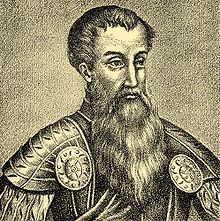Wilhelm von Roggendorf
Wilhelm Freiherr von Roggendorf (* 1481 ; † August 1541 in Šamorín ) was the Austrian colonel court master . He was a son Kaspar of rye village and came originally Styrian knight family of Roggendorf , since the mid-15th century in Austria below the Enns , such as Lower Austria was then called, was a resident. He was one of the commanders in the first Austrian Turkish War .
Life

Wilhelm von Rogendorf entered the service of the Habsburgs in 1491 . From 1517 to 1520 he was the governor of Friesland . In the second half of the 1520s he was court master to Archduke Ferdinand . He also commanded the heavy cavalry during the Turkish siege of 1529 under his brother-in-law Niklas Graf Salm (1459-1530) . In the following year he was appointed chief steward and in the following years was one of the most influential politicians in the circle of King Ferdinand I. He often represented Bernhard von Cles . In 1539 he gave up his offices, but was soon appointed commander of the armed forces that were sent to conquer Budas ( German oven ) in 1541 . During the siege of the Turkish fortress of Buda, which was disastrous for the Habsburgs, he was wounded, escaped to the island of Schütt , but died a few days later in Sommerein ( Šamorín ).
reception
Through the imperial resolution of Franz Joseph I of February 28, 1863, Wilhelm von Roggendorf was included in the list of the “most famous warlords and generals of Austria worthy of perpetual emulation” , in whose honor and memory there was also a life-size statue in the general hall of that time The newly established Imperial and Royal Court Weapons Museum (today: Heeresgeschichtliches Museum Wien ) was built. The statue was created in 1871 by the sculptor Rudolf Dominik Zafauk (1830–1889) from Carrara marble and was dedicated by Emperor Franz Joseph himself.
In 1894 the Roggendorfgasse in Vienna- Hernals (17th district) was named after him.
literature
- Johann Friedrich Kepner: Acts and character traits of famous Austrian generals. Volume 1. Degensche Buchhandlung, Vienna 1808, pp. 41–45. ( Full text in Google Book Search).
- Constantin von Wurzbach : Rogendorf, Wilhelm (I.) Freiherr von . In: Biographisches Lexikon des Kaiserthums Oesterreich . 26th part. Imperial-Royal Court and State Printing Office, Vienna 1874, p. 271 f. ( Digitized version ).
- Christian Brandstätter : City Chronicle Vienna. 2000 years in data, documents and images. Brandstätter, Vienna et al. 1986, ISBN 3-85447-229-3 .
- Alfred Kohler : Ferdinand I. 1503–1564. Prince, King and Emperor. CH Beck, Munich 2003, ISBN 3-406-50278-4 .
Individual evidence
- ↑ Johann Christoph Allmayer-Beck : The Army History Museum Vienna. The museum and its representative rooms . Kiesel, Salzburg 1981, ISBN 3-7023-0113-5 , p. 30
| personal data | |
|---|---|
| SURNAME | Roggendorf, Wilhelm von |
| ALTERNATIVE NAMES | Rogendorff, Wilhelm von |
| BRIEF DESCRIPTION | Austrian nobleman, chief steward and military person |
| DATE OF BIRTH | 1481 |
| DATE OF DEATH | August 1541 |
| Place of death | Šamorín |

